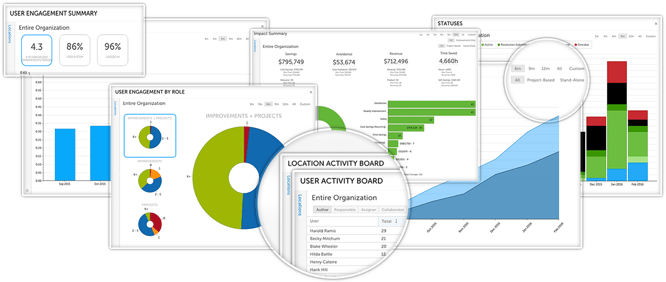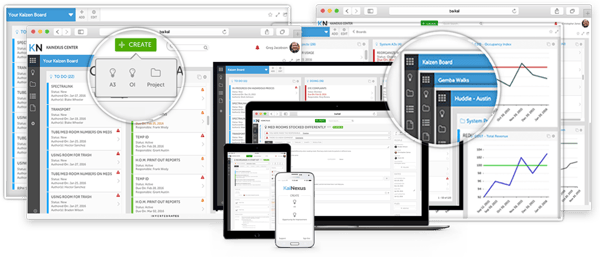 The Kanban visual management technique has been around since the late 1940’s when Toyota introduced it in its manufacturing plants. They were looking to improve efficiency and reduce waste, and in the process, paved the way for just-in-time manufacturing. At Toyota, workers used color-coded Kanban cards to signal to downstream workers when there was a need for parts. The word Kanban means “shopkeepers card” or “visual sign” in Japanese.
The Kanban visual management technique has been around since the late 1940’s when Toyota introduced it in its manufacturing plants. They were looking to improve efficiency and reduce waste, and in the process, paved the way for just-in-time manufacturing. At Toyota, workers used color-coded Kanban cards to signal to downstream workers when there was a need for parts. The word Kanban means “shopkeepers card” or “visual sign” in Japanese.
These days, the Kanban approach has been adopted and modified for use by workers in almost all industries. The most common display is a physical board that has cards moving from queue, in-progress, to complete. This is an excellent way to visualize work in progress and recognize backlogs or teams waiting for work. For small, centrally located groups, a physical board is often sufficient, but by taking the idea into the cloud, Kanban software companies have added significant value to the concept and made it possible to visually manage teams of any size no matter how many locations are involved. Here are the most compelling reason to consider Kanban software for your organization.
1 – You Have it Available 24 x 7 from Everywhere
The limitations of physical Kanban boards are apparent. They are only useful if you are physically present. However, in 2018 many teams work from a variety of locations. Telecommuting is becoming ever more popular, and people frequently take calls and attend meetings remotely. If you find yourself trying to describe your Kanban board or end up taking pictures and emailing them around, consider Kanban software instead. That way, everyone will have real-time access to the information, and if they get a great idea or need to make an update after hours, it’s no problem.
2 – It’s a Natural Way to Create a Knowledge Repository
A Kanban board on a wall serves as a snapshot of the current state of work. Unfortunately, it doesn’t tell you anything about what happened in the past. Kanban software, on the other hand, serves as a repository of information about every completed, in-progress, and planned project. Users can search through what’s been done before to find the best practices and avoid re-inventing the wheel. You can also attach documents to projects so that all of the relevant information is available in one space and you preserve one version of the truth.
3- It Includes Impact Measurement Capabilities
If you are using Kanban to track improvement related projects, it is critical to be able to calculate the impact of completed improvements over time. The best Kanban software solutions include measurement and reporting so that you can clearly articulate the business results of each project. This helps guide decisions about what projects to tackle next and justify your team’s investment in improvement work.

4- Success Broadcasting = More Success
Because of the limitations of physical Kanban boards, they are usually only viewed by folks involved in the projects on the board. However, leaders have learned through experience that sharing the success of each team broadly throughout the organization helps ensure more engagement and spreads improvement activities. Kanban software gives you a unified platform for sharing success far and wide.
5 – Leaders Can Manage Multiple Boards
A typical employee may need access to only one board, but department managers and executive leaders need a broader look at the work that’s being done in all corners. With Kanban software, leaders don’t need to take a hike around the building to get valuable insight. They can have as many boards as they need right at their fingertips. It is easy to drill down into specific projects for greater detail.

6 – Users Get Active Alerts and Notifications
Traditional Kanban boards are passive. Someone has to remember to move work cards from one stage to another or add new ones. They won’t tell you when a task is past due or alert the manager if forward progress stalls. Kanban software does all that with email notifications when new tasks are entered, a due date is reached, or a deadline is missed. Employees and managers alike get better control over projects, and more work gets completed faster.
7 - Strategic Alignment
Projects shouldn’t be taken on in a vacuum. Instead, they should be aligned to the most important strategic goals and objectives of the organization. Kanban software simplifies the task of cascading goals from the boardroom to the front line, ensuring that the right priorities are emphasized and that everyone understands his or her part in achieving success.
Kanban software isn’t a requirement, but if you are struggling to push projects over the finish line or wish you had more visibility into the status of work, it is an excellent investment.
![[Watch Now] Bottom-Up Improvement](https://no-cache.hubspot.com/cta/default/326641/804fb6fa-7d09-4472-9c33-824363af1f8a.png)


Add a Comment